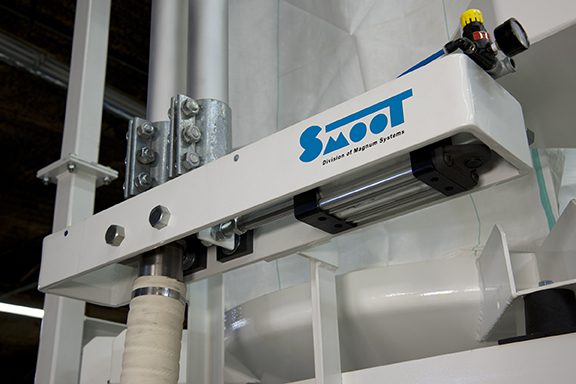

The Smoot Slide Diverter valve is in a class by itself. When many pneumatic conveying manufacturers were developing their product lines over 40 years ago, the common mindset was to design and manufacture from a casting and machining design. It made sense for the time for a couple reasons: 1) Manufacturer’s were already ordering castings for their rotary valves and, therefore, already had a machine shop; 2) castings were the “go-to” for manufacturing strong, long lasting parts. Think about how many automobile parts in a 1970’s era were manufactured from castings. Now… look under your hood today. New engineered materials and processes have replaced most of those old cast parts. Modern metallurgy has allowed the world to make parts from machine steel and weldments that are much stronger and half the weight of castings.
Maybe we were just ahead of our time, but our diverter valve was designed without any cast parts. We attach a flexible tube to a slide plate that moves back and forth over a very short distance to line up with the convey line we want to use. This design makes our valve superior to cast diverters by:
So why don’t other’s change to this design if it is superior? We can’t say with certainty, but for many manufacturer’s the problem with making changes to their design now is that it has a significant cost impact. One of the big problems with castings is that you can’t change them once they are designed. It costs too much to change the pattern or make a new one and they are heavy. Very heavy.
The Smoot Slide Diverter is not a new technology. We have installed thousands of these valves over the last 40+ years on materials from talc to ceramic, stone and silica. In addition, because the hose divert has no leaks or dead areas, it is perfect for food applications like flour, starch or sugars. As you can imagine, the reduction in cast metal weight, especially in stainless can add a significant cost reduction compared to cast valves as well. This helps make it not only right for many applications, but for many project budgets as well.
Related Post
Mastering Integration in Manufacturing with Magnum Systems: A Deep Dive Podcast Episode
The Secrets of Valve Bag Sealing: Expert Insights from Magnum Systems
Maximizing Efficiency in Production Lines: The Role of Rotary Airlock Valves
Addressing the Complexities of Valve Bag Sealing with Wayne Revell